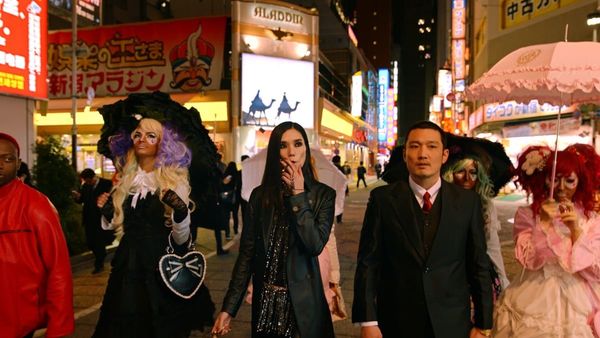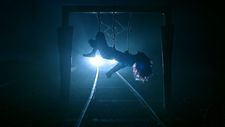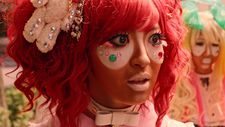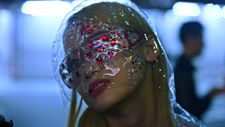 |
| She's Just A Shadow |
Sex, drugs, murder, gang wars, high fashion and low life on the streets of Tokyo: Adam Sherman’s stylish thriller She’s Just A Shadow has it all. It’s playing in US cinemas now and seems destined to become a cult favourite on DVD. Films that pull off this intense, multi-layered style are few and far between, so I was glad of the chance to speak to Adam about how it developed. I began by asking him about the shocking and visually striking opening scene, in which a serial killer takes a young woman from the boot of his car, ties her to the railway tracks and performs a sexual act before videoing her being hit by a train. Is the rumour true that this was inspired by, of all things, the adventures of kids’ cartoon hero Dudley Do-Right?
 |
| Never let your friends tie you to the railway tracks |
“That’s exactly where that came from, is Rocky And Bullwinkle,” says Adam. “The villain, Snidely Whiplash, would tie the lady down to the train track and Dudley Do-Right would show up in time every day and then put the villain in jail every day, and every night the villain would escape and do it again. And I remember seeing this when I was a little kid and thinking, like, it wouldn’t work like that. At some point the cop wouldn’t get there on time.”
It’s one of those curious things in cinema, I note, that everybody thinks women being tied to railway tracks happened all the time in silent films when in fact it was very rare. Adam does something strikingly different with the iconography of such scenes by using kinbaku, highly aesthetic Japanese rope bondage – but, he explains, it was a late addition to his plans.
“Originally, before I was going to shoot in Japan, I was just going to have the lady be bound and tied to the train track almost like she was lying in a coffin, but then once I decided to shoot the movie in Japan, they have this really amazing type of bondage called kinbaku and I decided that would look really good on camera so I decided to have the lady tied up like that... it was really cool because I got to work with a kinbaku master and he was excited to do it. Everyone actually had a great experience shooting it. Of course it’s kind of horrific to watch but we all had fun doing it.”
It’s a hell of a thing to throw at an audience which has had no time to prepare.
“Of course, putting that scene first is sort of a strong decision but it’s a stronger decision to have that scene in the movie at all. One of the points was to show people what they were in for in terms of watching the movie but another point was to show the physical aspects of what the murderer does first. Then I didn’t have to show the whole process of how he’s killing people later.”
 |
| Blending fashions for a unique look |
Why did he choose Japan for his setting?
“I wanted to shoot in an exotic, beautiful location. I wanted to do something different. It was mostly for the movie but it was also kind of just a mood that I was in and what I wanted to do with my life at the time. I wanted to go away and work somewhere different. In terms of the US I was thinking of New Orleans and San Francisco, and then I was also thinking of Montreal because I grew up in Vermont and I spent a lot of time in Montreal and it’s also a beautiful city. But then I started researching Tokyo online and looked at a lot of pictures of Tokyo, and I ended up talking to a line producer who’s Tokyo based and I started to talk to people in Tokyo and sent them the script. They were responding positively to it and at the same time I was printing out images of different things and styles in Japan and before I knew it the walls of my office were just covered. And I got involved with a Japanese production company that was excited to do it and it all just came together.”
He ends up doing a great deal with Japanese fashion and aesthetics, in some fantastic combinations. Did that influence his overall visual style?
“Yeah. I mean, I was looking at different ways that people dress in Japan online and of course I don’t really know about the culture in Tokyo, so when I got there and I showed the costume designers and the make-up designers they were saying that I picked the clothes of what they call Lolita and then the make-up of what they call yamanba but the two things never went together, like two different styles, so they were like ‘You know this was never really a real style,” and I was like ‘Okay, can we put it together?’ and they were like ‘Sure.’
“I just picked things that I thought were cool and put it together and then of course we added details, things like the jewels on the face – that exists in all different cultures – I just liked the way it looked and I just kept telling the make-up artist to do more and more of it.”
 |
| You can't have too many jewels |
There are lots of interesting motifs in the film around filming and being filmed.
“These days there’s just so much weird stuff with phones and what they can do, tracking and videoing and people posting weird things online,” he says. “It affects governments and businesses and all sorts of things. So to me the idea that this serial killer might do this and how, it’s just like something that somebody might do, tracking them through their phones and being able to see them. I don’t think it’s like a futuristic idea of anything, it’s a thing that could be done with technology that exists right now.
“People are getting killed by making mistakes with apps and, like getting into an Uber that is not and Uber or something. Some lady was killed in LA because of that, she just got into someone’s car innocently and it was a serial killer’s car. It’s just what happens.”
The film is notable in the way it handles lots of different characters, bringing out the humanity in each of them despite all the strange things happening around them. Sex workers and gangsters, especially in ensemble films, often miss out on that kind of character development.
“I think it’s just like my style of writing, Adam says. “Everybody has a personality and is someone. I just have a lot of characters because that’s the way I write and the way I direct. All the people are just people and you know, oftentimes I put dialogue into movies, like sometimes when I’m in public I’ll just hear a funny conversation, like just strangers talking, and they say some really peculiar stuff. And I remember the conversation and go write it down and then while something is happening like a drug deal I’ll just take the conversation that I may have overheard in like a restaurant and I’ll just have the gangsters have that conversation while they’re doing the drug deal. I think that humanises them in some way.”





















